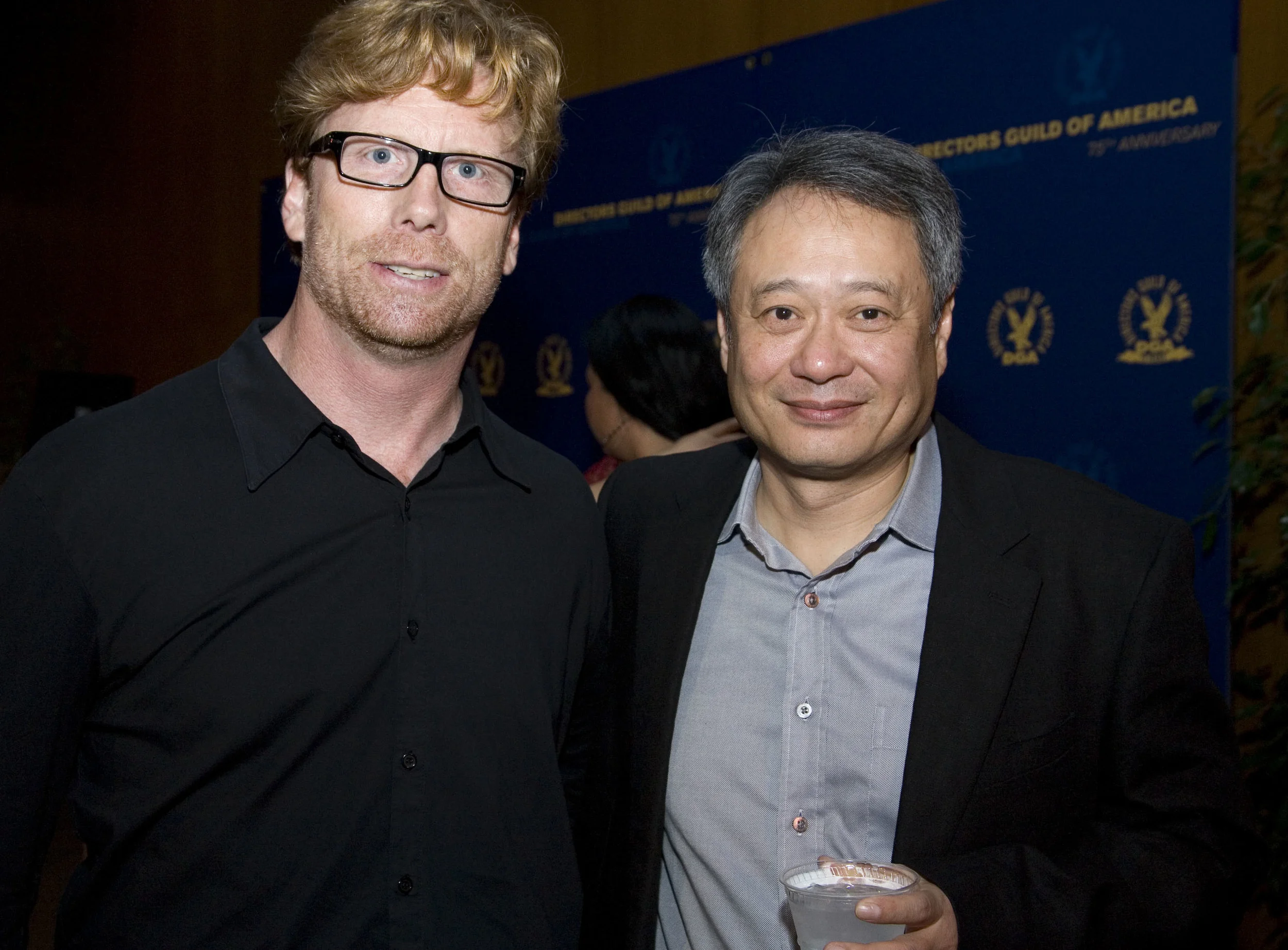Bryan Unger with Director Ang Lee. Photo credit Directors Guild of America
G. Bryan Unger is the Associate National Executive Director of the Directors Guild of America. In our conversation we discussed the relationship between the DGA and ADG, how it’s changed since the ADG’s unionisation and the challenges facing directors guilds now and in the future.
How do you see the relationship between the ADG and DGA? Has it changed over time?
The ADG formed as a fraternal organisation (the Australian Screen Directors Association) early on. They weren’t certified as a union, but they got a lot of Australian Directors together, going back to the first wave of Australian films – the Peter Weir, Philip Noyce, Fred Schepsi and Gillian Armstrong group. They were making films in Australia, which were then getting noticed in the U.S., and a lot of those directors were coming over to work for American studios, and eventually joining the DGA.
The relationship between the DGA and the ADG began when the ADG started taking on a more formal structure in the 1990s (again, as ASDA at that time). There were some meetings with the English-speaking directors organisations: Directors Guild of Canada, DGA, the former Directors Guild of Great Britain and ASDA – we have been in communication and exchanging ideas for some time. The recent activity to become a union has sparked a renewed interest and opportunity to talk to people again and to help the ADG to facilitate its union’s formation.
Having now unionised do you think that’s going to help the current generation of Australian Directors coming to America and vice versa? Or is it more about guidance and the working relationships with producers, studios and production companies?
We’ve always had a great relationship with Australians – there are a number of people working here now who have fostered that. I don’t know that it affects the individual so much coming from here to there, though it does help. For instance, with the Directors Guild of Canada, we have a more formalised structure because there is a sister organisation to talk to if there are any issues. I do think it changes the way we deal with productions from the U.S. going to Australia.
There are really three things going on in Australia: One is local production for Australian television and films. Secondly, there is international production – a great example is the recent announcement of Disney and Fox producing films that content-wise are not inherently Australian, they just happen to be filming in Australia. This is an area where we have a lot of experience dealing with conglomerates and at those budget levels. I think we can help add value to the ADG’s relationship there.
Third is the re-use issue, which always comes up. For example, the re-runs of Friends that end up on Australian TV and of course the Australian Directors always say that the local producer can’t produce original content cheaper than they can buy the re-run of Friends. Our directors share in some revenue of the sale of U.S. content to other markets, just like we hope Australian directors will one day share in the revenue streams of the projects they work on. On the other side of the coin, we want to encourage and promote Australian production. There’s a bigger international market that’s opening up because of online platforms like Netflix, Amazon and Hulu. These companies are looking to acquire content and people are interested to see it. Top of the Lake was not Australian – but from New Zealand – and is an example of something that really found its audience through online platforms.
“It’s important to recognise and I believe the ADG recognises this too, that if you produce good content, people will watch.”
It’s interesting considering online, in terms of the Australian quota systems for broadcasters - yet the online players aren’t beholden to the same system. How do you see that as a challenge - particularly for Australian directors?
Each country has to look at where they are and what they want to promote in terms of their broadcasting. In some countries, it was found that without some form of government intervention, re-use and sports dominate.
In Australia, people are sports fanatics and watch of all kinds of sports. If you don’t have some protected space for dramas, you might not ever get them on television.
I look at much of the US programming in Australia as akin to dumping of agricultural produce - because we lack the language barrier that operates as a certain filter in many other markets - sure there’s the flip where our talent can come and work here with greater ease - but it does bear some focus on not the free speech issue, but rather the transformation of the economic models
It’s important to recognise and I believe the ADG recognises this too, that if you produce good content, people will watch.
When all they have are re-runs of Friends, we find that the audience will watch re-runs of Friends. But if they ever have a choice – and this is as true in Canada as well as Australia – local productions are almost always more popular in terms of ratings, because people want to see their own culture.
But it has to be well made.
And the caveat is that the broadcaster has to put up the money, hire the people, and develop the scripts, as well as pay directors who know what they’re doing to make it good. The director plays a critical role in making good content that people will watch.
I’m curious in terms of craft - we have Thomas Schlamme coming to Australia to talk about his craft and hopefully be the first of many directors who visit - is there something that we can do to face some of these challenges? And the overall sharing of knowledge?
That is really the goal of this first step that we’re taking. There are two levels, the first of which is that there is a lot to share in terms of the craft. Tommy is a great example of someone who has directed a lot, and at a very high level. His experiences will be helpful to other directors around the world, but particularly Australia. We have always been interested in the cultural exchange. It’s evolved naturally with people from Australia being involved with the DGA, such as Philip Noyce, who has been on our creative rights committee for many years.
Despite all the evolution in technology, at its core the process of a director taking a script, breaking it down, visualising it, guiding the actors through and covering it to make it visual - remains largely the same.
The tools around it have changed significantly; editing, lighting, cameras. But the core hasn’t really changed. Directors have found new and exciting ways to work with actors to elicit better performances and if you look back at older shows, there’s a much more naturalistic style now.
On that level, we’ve always been interested in sharing the craft.
In terms of the business, there is an internationalisation of the broadcasting business. Film preceded this. Our experience in international productions can be helpful and some of it translates to local production – but then there are things like the economics of Australian television, which are different.
The goal is really to be in a position to leverage our experience to offer assistance both on the business side and on the craft side.
“A union helps to protect the director not just economically but by creating a framework within which they can do better artistic work.”
What else do you see as advantages of union recognition?
It’s very important that the ADG is being recognised as a union, and that they are being allowed to represent directors as artists. Our experience, which goes back almost 80 years, shows that artists in the entertainment industry need representation. This is a complex business in which large corporations with a lot of money are in in the position to potentially exploit the talents of an individual. Without some collective protection, and this is true for actors, writers and directors – the individual artist can have a very hard time surviving in that environment. In the freelance environment, a director might be hired for an episode, but if the producer doesn’t happen to like her or him, they just don’t hire them again. They don’t even have to provide a reason, it’s just “see you later.” So it’s very difficult in that environment – and we see it in other parts of the world where there isn’t union representation for the director to say “Hey wait a minute, you paid me $3000 last week and now you want to pay me $2500, well I’m not going to accept that,” and instead the producer can just say “I’ll just get the next guy or woman to do it.” We understand that collectively bargained protections, including minimum rates, terms and conditions are paramount.
It is also important for the protection of directors as artists. A union helps to protect the director not just economically but by creating a framework within which they can do better artistic work. They can be more creatively bold when they’re not worried about having their payments cut.
It’s an exciting time for the ADG to be moving into this representation area, which is long overdue.
What do you see as some of the most immediate challenges going forward? It almost feels like in Australia it’s evolved in a business model more akin to the Silicon Valley model, in that it is individuals against corporations. Going forward from Australian directors’ slightly weaker position do you think that the entrenched culture will face different hurdles? Is there some catching up to do for the ADG to be at parity with the DGA in terms of weight? And are there aspects that because we have had 80 years without a union, that will be harder to reverse?
The ADG has some catching up to do, but they’re starting now and they have taken a big step forward. Australia does have unions in the entertainment industry, MEAA is very powerful, so it is not like the ADG is starting from scratch.
The DGA in the United States is the product of eighty years of work, of coming from a different time when there were studios and the directors were their employees. As the entertainment industry workforce has moved towards the freelance model where the individual moves around from employer to employer, some of the social protections they might have had as an employee of a single employer were lost.
What the Directors Guild of America, Screen Actors Guild, Writers Guild of America, the International Alliance of Theatrical Stage Employees and the Teamsters do in the U.S. is fill in that gap. They become a social safety net by negotiating for and maintaining health and pension plans, and providing many other protections and services to their members.
The unions and guilds actually serve a function for the producer too. In our case, we do a lot of things like education, where we take on a lot of expenses to train our members, which the employers really benefit from. The ADG is the same. We’re bringing Tommy, who will talk with directors and maybe a couple will hear something that will make them better. Who’s going to benefit from that? The Australian broadcaster is going to benefit, having spent nothing for it. The guilds all work on professional development which is in service to their members and the industry.
There is a broader context that you have to look at, which really goes to the protection of the artist. Think about Australian culture and the filmmakers I mentioned, and their impact on the perception of Australia domestically as well as abroad. Those movies were exported and people around the world saw the Australian experience through the eyes of the filmmaker. That filmmaker – the director – created an experience for them and that’s really powerful. They certainly deserve to be fairly compensated and credited for their efforts.
Do you have any thoughts on the changing models of distribution for films in Australia, given the disparity in scale between most Hollywood films marketing budgets? Especially given the rarity of studio backing in Australian films?
Advertising and promotion, at least in terms of the budgets available to them, have really hurt independent films in the U.S. and it is a similar case for the Australian film.
There are influencers in the media. There are people who, like Pauline Kael, could write a review about somebody and make or break them. Literally. One review could make or break a filmmaker.
That still exists today in a certain way, through social media. One of the things that we have to do, to support independent film is to help our people find those influencers and reach out to them to steer people in their direction.
A lot of independent filmmakers are using social media. As the world has changed, it has become the go-to means to promote film. They start pushing out (tweeting) promotion stills and little leaks about something that happened on the set, so that you get social media talking about the film, because it’s free… well maybe it won’t be forever, but right now it’s free!
In terms of promoting films, directors have to think in a different way. Then there’s the reality of deciding whether you want your project to be seen in the theatre, or go with the home experience.
Again it’s that issue of creating the experience that’s going to draw people in. We also have to support the infrastructure. You can make the greatest film in the world, but if there are no theatres to show it in, then it’s probably going to be only on television, because that’s the only outlet. You also have to look at the theatre owners in Australia and decide if it’s viable for them.
In Los Angeles we have a pretty good theatre-going audience and it’s not just because the business is here, people in L.A. like going to the movies. We also have some of the best theatres in the world. In fact we happen to be sitting on top of one of them. But when you go outside the major cities, it becomes a little harder for people to drive to the local cinema – and then if the experience isn’t really good, if the projection isn’t really high quality, or it’s out of focus a little bit or the sound’s a little off, then people start to question why they paid all this money for the experience.
Australia is definitely one of the highest saturation markets though, with several billion in box office each year. Especially with 2015 being the biggest box office year ever, with Mad Max and The Water Diviner carrying over and other films really helping to boost the numbers. That said, I can already see the headlines for 2016 which will promote doom and gloom, simply because it won’t be as big as this outlier year.
Definitely. For English language audio-visual products it’s a very big market.
How is that looked at from a guild’s perspective? Is there any way we can approach theatre owners and try to collaborate on achieving a better result?
With the ADG, you have a collective voice where you can go and meet with the theatre owners and voice concerns collaboratively. Should we go to the government together? How can we help each other? It opens up strategic partnerships and alliances, and where you have the strength of the body of directors. The opportunity the ADG has is to become the voice of filmmakers in a much more powerful way than it has been in the past.
“There are great stories of the founding of the DGA – which was established not by people who were struggling for work, but by people who had become very successful and said “We need to do this because of the people coming behind us.””
We have quite a lot of directors in Australia who have grown up in an everyone-for-themselves kind of framework. How should directors who have grown up in that environment see the value in coming together?
It’s not just Australians in the everyone-for themselves-situation. There are great stories of the founding of the DGA – which was established not by people who were struggling for work, but by people who had become very successful and said “We need to do this because of the people coming behind us.” They recognised that without a guild, they would just get cut to ribbons by themselves.
When directors get together and start talking about the issues, they find the commonality of the things that they encounter to be very compelling.
It’s important in today’s society to remember that artists need to be able to make a living to continue to be artists. That’s why coming together gives a little bit more power, along with professionals who can advise the organisation. The pooling of the collective wisdom is important. In the U.S. for instance, residuals are a good example. By pooling resources and using economies of scale, the DGA is able to track, collect and distribute money to the directors much more efficiently than they could on their own.













